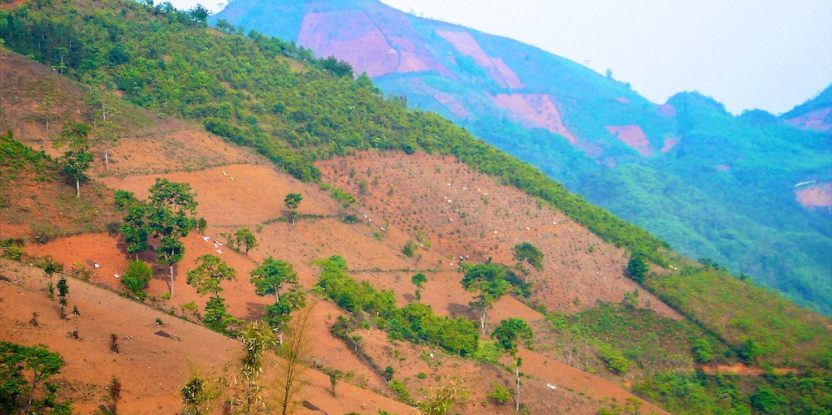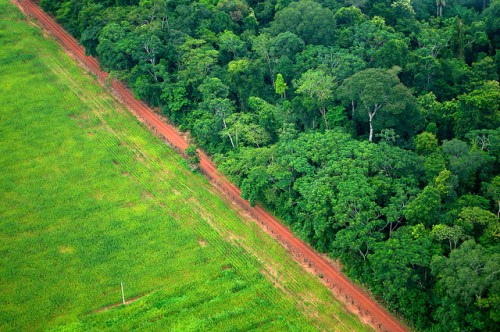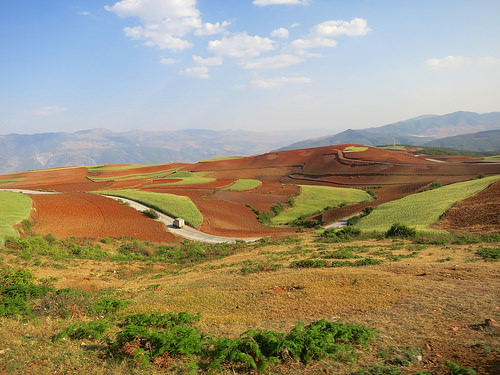First the land was baked dry, then the torrential rains came – sweeping away homes, crops, forests and human lives.
In 1997, the El Niño Southern Oscillation (ENSO) climate event (among other factors) brought a 267-day drought to China’s Yellow River Basin, and the following year floods poured across vast swathes of the country as the Yangtze, Songhua and Pearl rivers broke their banks. As many as 3,600 people were killed, and 13.2 million were left homeless.
The impacts didn’t stop there – the floodwaters swept a new way of thinking into Chinese policy, the effects of which are still being felt today.
Logging in state forests and smallholder agriculture on steep hillsides were blamed for causing soil erosion and increasing the flood risk, and China’s government radically reoriented national forest policy away from a focus on timber production – and towards forest conservation and restoration.
More recent research has questioned the role of forests in preventing large-scale floods – and forest loss and degradation has been widespread in both ancient and contemporary China. But the extreme weather events of the late ’90s, and the deteriorating environment, galvanized the government into action.
In 1998, logging in natural forests was banned in the upper reaches of the Yangzte and Yellow rivers, and in 1999 the government brought in the Conversion of Cropland to Forest Program (CCFP) – a massive afforestation scheme aimed at reducing both erosion and poverty by encouraging farmers to plant trees on sloping and ‘barren’ lands.
They were given money to buy saplings and seeds, as well as a subsidy to compensate for lost agricultural income. The payments were conditional on the trees surviving – 70 to 85 percent of them, depending on local criteria.
“There are some similar programs in other tropical developing countries converting sloping lands to forest – but this is by far the biggest program in terms of area and investment,” says Lucas Gutiérrez Rodríguez from the Center for International Forestry Research (CIFOR).
Impacts on land, impacts on people
The CCFP has been implemented in 25 Chinese provinces, at a cost of $US 50 billion – and almost 30 million hectares of land have been converted into forest. It’s now been running for 17 years.
“Broadly speaking, land use changes brought about by the CCFP have been positive,” Gutiérrez Rodríguez says. “The forest cover has increased fast in all CCFP implementation areas.”
In a new paper, Gutiérrez Rodríguez and colleagues have brought together the results of 43 academic studies published in English about the program. They found that it has been particularly effective at increasing forest cover and carbon stocks.
“It has also been quite successful in terms of tree survival rates,” Gutiérrez Rodriguéz says. “Around 80 percent of participating households in the program have achieved tree survival rates of at least 70 percent, which is quite an achievement, taking into account the wide coverage of the program.”
Has the program reduced soil erosion and flood risk as hoped? There aren’t many studies in English that directly address this, Gutiérrez Rodriguéz says, there is some evidence of reduced erosion in one area, the Loess Plateau. Some studies found that in arid areas, afforestation often comes with a significant trade-off. Through evapotranspiration, the planted trees suck up more of the moisture in the environment, Gutiérrez Rodríguez says. “That means less water availability for other local trees to grow, and also for downstream users.”
Another less-positive impact has been on biodiversity, although not many studies in English have examined this, so the sample size is small, Gutiérrez Rodriguéz says. On Hainan Island, for example, an expansion of monoculture plantations of eucalyptus and rubber had a negative affect on biodiversity; as did the use of inappropriate non-native tree species in Shaanxi province and Longyang district (Yunnan province).
The CIFOR researchers also synthesized studies on the social impacts of the program. Those too have been generally positive, Gutiérrez Rodríguez says, although there is huge variation across China and over time.
“The program has prompted some farmers to change their own livelihood strategies from on farm production to a diversified array of different sources of income – and in general they have been growing their income levels.”
“Despite some challenges in terms of diminished local food production in some areas, in general farmers have been able to cope with these changes and find new forms of employment.”
This is critical to the program’s long-term success – because if the benefits don’t allow poor farmers to meet their food and livelihood needs, they are likely to turn those new forests back into cropland, undoing the work of the scheme in an instant.
Several studies asked farmers about their intentions when the CCFP ended and they stopped receiving subsidies. In some areas, up to third said they planned to reconvert their forests into cropland.
“Based on these findings we can say that the program is in need of novel strategies targeting ecological restoration and livelihood improvement in more holistic and socially inclusive ways,” Gutiérrez Rodriguéz says.
“Ideally, site selection should minimize encroachment on indispensable fertile agricultural lands and bio-diverse areas, to safeguard local food security and ecosystem service delivery in the long term.”
“Subsidies and other payments need to justly compensate people for the opportunity costs of retiring their land – and they also need to be better targeted, to ensure money is distributed fairly among both rural and urban populations, migrants, and groups facing specific identity- or context-related challenges,” he says.
Synthesizing findings
More long-term research is also required to better quantify the CCFP’s environmental outcomes, Gutiérrez Rodríguez says – important both for policy implementation in China, and for restoration ecology globally.
He’d also like to see more research into the social impacts of the program – particularly inequalities linked to off-farm development, and how the CCFP influences migration.
Of course, the English-language studies only capture some of the information about how the Conversion of Cropland to Forest program has played out over the past two decades.
It’s the first time there’s been a systematic attempt to synthesize all the findings
There are many more studies in Chinese, and Gutiérrez Rodríguez and colleagues are now analyzing 175 Chinese-language papers on the CCFP, pulling together an even more detailed and accurate study of this influential scheme.
“It’s the first time there’s been a systematic attempt to synthesize all the findings,” Gutiérrez Rodríguez says.
“We thought it was important to do that to provide an input for Chinese researchers and institutions to improve the implementation of the program, and to get some conclusions that could be relevant for other similar programs in other parts of the world.”
We want you to share Forests News content, which is licensed under Creative Commons Attribution-NonCommercial-ShareAlike 4.0 International (CC BY-NC-SA 4.0). This means you are free to redistribute our material for non-commercial purposes. All we ask is that you give Forests News appropriate credit and link to the original Forests News content, indicate if changes were made, and distribute your contributions under the same Creative Commons license. You must notify Forests News if you repost, reprint or reuse our materials by contacting forestsnews@cifor-icraf.org.



